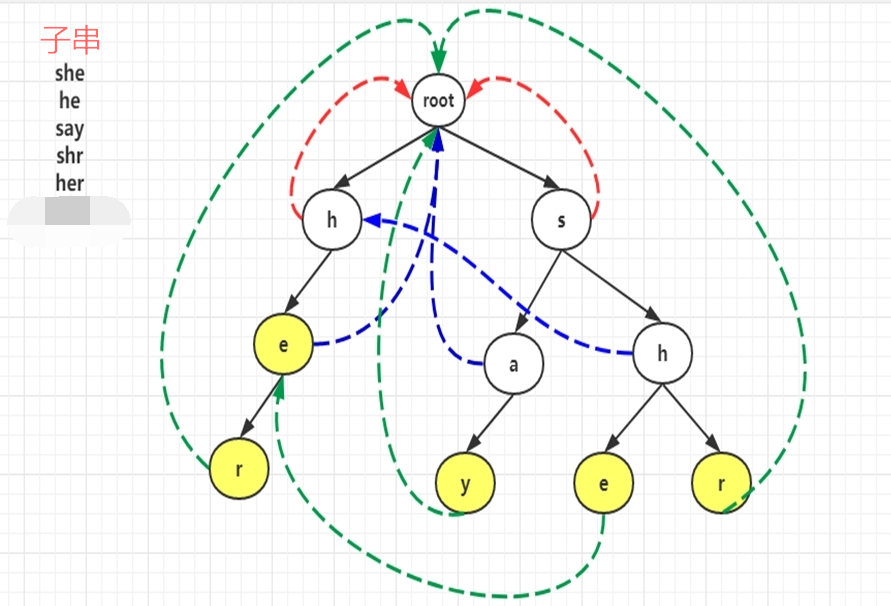构建步骤
AC自动机的构造分成两步:
- 构造Trie树
- 在Trie树的基础上构建fail指针(相当于KMP的next数组)
fail
构造失败指针的过程概括起来就一句话:设这个节点上的字母为C,沿着它父亲节点的失败指针走,直到走到一个节点,它的子结点中也有字母为C的节点。然后把当前节点的失败指针指向那个字母也为C的儿子。如果一直走到了root都没找到,那就把失败指针指向root。
具体操作起来只需要:先把root加入队列(root的失败指针指向自己或者NULL),这以后我们每处理一个点,就把它的所有儿子加入队列。
观察构造失败指针的流程:对照图来看。
(1) 首先root的fail指针指向NULL,然后root入队,进入循环。
(2) 从队列中弹出root,root节点与h、s节点相连,因为它们是第一层的字符,肯定没有比它层数更小的共同前后缀,所以把这2个节点的失败指针指向root,并且先后进入队列,失败指针的指向对应图中的(1),(2)两条红线;
(3) 从队列中先弹出h(左边那个),h所连的只有e结点,所以接下来扫描指针指向e节点的父节点h节点的fail指针指向的节点,也就是root,root->next[‘e’] == NULL,并且root->fail == NULL,说明匹配序列为空,则把节点e的fail指针指向root,对应图中的蓝色,然后节点e进入队列;
(4)从队列中弹出s,s节点与a,h(左边那个)相连,先遍历到a节点,扫描指针指向a节点的父节点s节点的fail指针指向的节点,也就是root,root->next[‘a’] == NULL,并且root->fail == NULL,说明匹配序列为空,则把节点a的fail指针指向root,对应图中的蓝色,然后节点a进入队列。
(5)接着遍历到h节点,扫描指针指向h节点的父节点s节点的fail指针指向的节点,也就是root,root->next[‘h’] != NULL,所以把节点h的fail指针指向右边那个h,对应图中的蓝色,然后节点h进入队列…由此类推,最终失配指针如图所示。
演示
Go创建AC
package goAcAutoMachinetype AcNode struct {fail *AcNodeisPattern boolnext map[rune]*AcNode}func newAcNode() *AcNode {return &AcNode{fail: nil,isPattern: false,next: map[rune]*AcNode{},}}type AcAutoMachine struct {root *AcNode}func NewAcAutoMachine() *AcAutoMachine {return &AcAutoMachine{root: newAcNode(),}}func (ac *AcAutoMachine) AddPattern(pattern string) {chars := []rune(pattern)iter := ac.rootfor _, c := range chars {if _, ok := iter.next[c]; !ok {iter.next[c] = newAcNode()}iter = iter.next[c]}iter.isPattern = true}func (ac *AcAutoMachine) Build() {queue := []*AcNode{}queue = append(queue, ac.root)for len(queue) != 0 {parent := queue[0]queue = queue[1:]for char, child := range parent.next {if parent == ac.root {child.fail = ac.root} else {failAcNode := parent.failfor failAcNode != nil {if _, ok := failAcNode.next[char]; ok {child.fail = parent.fail.next[char]break}failAcNode = failAcNode.fail}if failAcNode == nil {child.fail = ac.root}}queue = append(queue, child)}}}func (ac *AcAutoMachine) Query(content string) (results []string) {chars := []rune(content)iter := ac.rootvar start, end intfor i, c := range chars {_, ok := iter.next[c]for !ok && iter != ac.root {iter = iter.fail}if _, ok = iter.next[c]; ok {if iter == ac.root { // this is the first match, record the start positionstart = i}iter = iter.next[c]if iter.isPattern {end = i // this is the end match, record one resultresults = append(results, string([]rune(content)[start:end+1]))}}}return}


